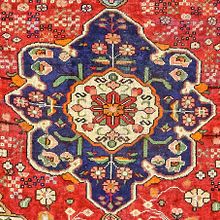Mahabad Rug
Jump to navigation
Jump to search
| Mahabad Rug | |
|---|---|
 Design of Mahabad Rug (Rugman) | |
| General information | |
| Name | Mahabad Rug |
| Original name | قالی مهاباد |
| Alternative name(s) | Mahabad Carpet (Sauj Bulagh Rug) |
| Origin | |
| Category | City |
| Technical information | |
| Common designs | Geometric |
| Common colors | Red, Blue, Ivory, Begie |
| Dyeing method | Natural, Synthetic |
| Pile material | Wool |
| Foundation material | Cotton |
| Knot type | Symmetrical (Turkish) |
Mahabad rugs originate from Mahabad, formerly called Savojbolagh Mokri, in the province of Azerbaijan in northwestern Iran near Tabriz. Mahabad has been an important Kurdish center since the 19th century and served as the capital of a brief Kurdish Republic (consisting of the northern part of Persian Kurdistan, with Kurdish as the official language) from 1945-46. Mahabad weavers produce mainly a Turkoman area rug. The distinguishing feature of Mahabad rugs is the frequent use of an all-over pattern of small Turkish designs on very soft and luxurious pile. An area rug from Mahabad has a flat back and is woven with very rounded symmetrical knots.
History
Mahabad is the modern name of Sauj Bulagh.[1]
See also
| Search for Mahabad Rug on Wikipedia. |
References
- ↑ Moheban, 2015, 364
Bibliography
- Abraham Levi Moheban. 2015. The Encyclopedia of Antique Carpets: Twenty-Five Centuries of Weaving. NewYork: Princeton Architectural Press.